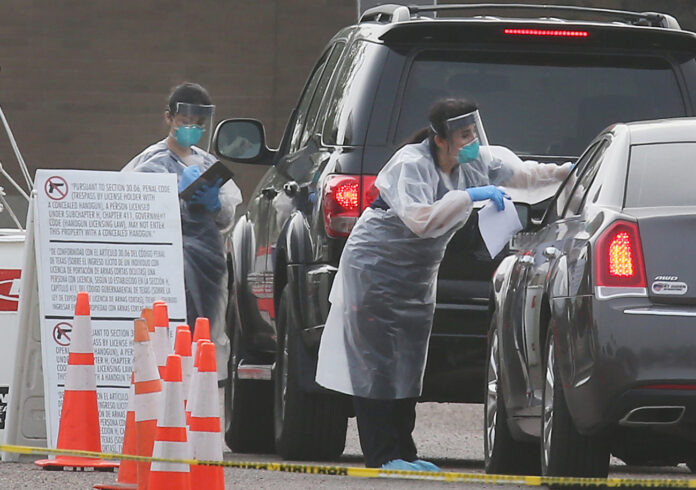Hidalgo County’s death toll from the COVID-19 pandemic reached 829 Monday evening, and data on the deaths along with observations from health authorities has painted a picture of the average virus victim in the area that can be summed up in two words: older and overweight.
County Health Authority Ivan Melendez says the demographics of the Rio Grande Valley make the coronavirus especially lethal: many residents are more at risk because of diabetes or obesity, and other demographics make slowing transmission a difficult task to accomplish.
Those factors have led to a 4.1% fatality rate among the county’s confirmed cases.
“We’re the perfect storm for deaths,” he said. “We’re poor, we don’t have access to primary care, we have the two largest associated risk factors, obesity and diabetes, we’re uneducated and our average age is 29 years old. There’s no telling a 29-year-old what to do, they’re going to go party and hang out.”
Data released by the county demonstrates just how deadly COVID-19 can be for the elderly.
Residents above the age of 60 account for at least 619 of the 829 fatalities the county had reported as of Monday, just shy of 75%; residents above the age of 70 account for at least 452 of those 619 deaths.
With the county reporting 1,807 positive COVID-19 cases in the 70-plus demographic Monday, those 452 deaths make the chances of not surviving the coronavirus for such residents about 1 in 4.
In comparison, the number of fatalities for younger residents has been significantly lower, with only 38 deaths being reported for residents below the age of 40, less than 5% of the 829 dead.
That doesn’t mean younger residents are immune to the coronavirus, Melendez said.
“There’s still plenty of 30 and 40 and 50 year olds that are dying, but almost universally all the 30 year olds that die … their BMIs are in the 40s, they’re all obese,” he said.
Obesity and diabetes aren’t factors tracked by the county’s COVID-19 dashboard or its nightly coronavirus news releases. Melendez says they are factors that are evident to anyone in the medical or funerary fields.
“If you go to the morgues the way I have, everybody looks the same,” he said. “They’re all purple, of course, cause they’re dead, these poor cadavers. They all have big stomachs. They’re all obese and the vast majority are old, they look old, they have white hair.”
Juan Lopez, a body courier based out of McAllen, echoed that while he described younger casualties he had picked up and transported.
“Most of the people that we’ve been picking up, they’re obese people: 400, 500 pounds,” he said.
Other data is available for the county’s casualties, although Melendez says those statistics aren’t as relevant.
Of the 775 fatalities with identified places of residence attached, 531, a little under two-thirds of the total 829 deaths, were in Hidalgo County’s biggest cities: 184 deaths for McAllen, 159 for Mission, 110 for Edinburg and 78 for Pharr.
Deaths in Alamo and San Juan account for 100 of the additional fatalities, with Mid-Valley cities accounting for just over 100 more.
Smaller towns were not spared either and they account for many of the remaining casualties.
Many smaller municipalities have been identified in the county’s lists of the dead.
Alton and Hidalgo, for example, have lost 15 residents apiece. Sullivan City, Penitas, Palm View, Palmhurst and La Joya have all lost less than five residents apiece to the virus so far.
Over 50 of the 829 are listed as undisclosed, with the specific location being withheld because of the small size of the town.
Curiously, McAllen has lost at least 74 more residents to the virus than Edinburg despite having almost 500 fewer COVID-19 cases confirmed among its residents and the lowest rate of per capita infection for Hidalgo County municipalities.
Melendez attributes the phenomenon to drastic testing efforts that have been conducted in Edinburg.
“Edinburg has always had more test positive because that’s where the testing’s at,” he said.
Melendez said that comparing casualties by municipality is likely a waste of time, in comparison with comparing Hidalgo County with other counties or regions.
“For us, I think it’s an artificial and not well-served energy to try to focus on particular clusters per municipality because we’re pretty much an open community and that doesn’t give us much information,” he said.
Another thing shown by county data is COVID-19’s impact through the lens of gender. Of the county’s confirmed cases, 54% are female, 45.3% are male and .8% are undetermined.
In contrast, about 60% of coronavirus-related fatalities in the county have been male.
Melendez says the sample size is likely too small to draw anything useful from that data. Perhaps there’s just more women getting tested in the area, he said.
“I don’t think that there’s a particular sexual predisposition if you’re male versus female that you’re more at risk,” he said.




